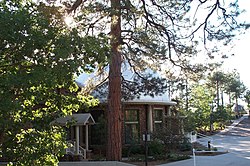 The Clark Telescope Dome on Mars Hill | |||||||||||||||||||||||||||||||||||||||||||||||||
| Alternative names | Flagstaff Observatory | ||||||||||||||||||||||||||||||||||||||||||||||||
|---|---|---|---|---|---|---|---|---|---|---|---|---|---|---|---|---|---|---|---|---|---|---|---|---|---|---|---|---|---|---|---|---|---|---|---|---|---|---|---|---|---|---|---|---|---|---|---|---|---|
| Organization | Private institution | ||||||||||||||||||||||||||||||||||||||||||||||||
| Observatory code | 690 | ||||||||||||||||||||||||||||||||||||||||||||||||
| Location | Flagstaff, Arizona | ||||||||||||||||||||||||||||||||||||||||||||||||
| Coordinates | 35°12′10″N 111°39′52″W / 35.20278°N 111.66444°W | ||||||||||||||||||||||||||||||||||||||||||||||||
| Altitude | 2,210 m (7,250 ft) | ||||||||||||||||||||||||||||||||||||||||||||||||
| Established | 1894 | ||||||||||||||||||||||||||||||||||||||||||||||||
| Website | lowell.edu | ||||||||||||||||||||||||||||||||||||||||||||||||
| Telescopes | |||||||||||||||||||||||||||||||||||||||||||||||||
| |||||||||||||||||||||||||||||||||||||||||||||||||
| | |||||||||||||||||||||||||||||||||||||||||||||||||
Lowell Observatory is an astronomical observatory in Flagstaff, Arizona, United States. Lowell Observatory was established in 1894, placing it among the oldest observatories in the United States, and was designated a National Historic Landmark in 1965.[2][3] In 2011, the Observatory was named one of "The World's 100 Most Important Places" by Time Magazine.[4] It was at the Lowell Observatory that the dwarf planet Pluto was discovered in 1930 by Clyde Tombaugh.
The observatory was founded by astronomer Percival Lowell of Boston's Lowell family and is overseen by a sole trustee, a position historically handed down through the family. The first trustee was Lowell's third cousin Guy Lowell (1916–1927). Percival's nephew Roger Putnam served from 1927 to 1967, followed by Roger's son Michael (1967–1987), Michael's brother William Lowell Putnam III (1987–2013), and current trustee W. Lowell Putnam.
Multiple astronauts attended the Lowell Observatory in 1963 while the moon was being mapped for the Apollo Program.[4]
The observatory operates several telescopes at three locations in the Flagstaff area. The main facility, located on Mars Hill just west of downtown Flagstaff, houses the original 61-centimeter (24-inch) Clark Refracting Telescope, which is now used for public education, with 85,000 annual visitors. The telescope, built in 1896 for $20,000, was assembled in Boston by Alvan Clark & Sons and then shipped by train to Flagstaff. Also located on the Mars Hill campus is the 33-centimeter (13-inch) Pluto Discovery Telescope, used by Clyde Tombaugh in 1930 to discover the dwarf planet Pluto.
In 2014, the 8,000 square feet (740 m2) Putnam Center was opened.[5] This observatory included many rooms with tools that were useful to observers including a library for research, a room for processing photographic glass plates, multiple antique instruments used by previous astronomers, and many artifacts. The observatory does contain areas that are closed to the public view, although there are multiple places that tourists are welcome to visit.[4]
Lowell Observatory currently operates four research telescopes at its Anderson Mesa dark-sky site, located 20 km (12 mi) southeast of Flagstaff, including the 180-centimeter (72-inch) Perkins Telescope (in partnership with Boston University) and the 110-centimeter (42-inch) John S. Hall Telescope. Lowell is a partner with the United States Naval Observatory and Naval Research Laboratory in the Navy Precision Optical Interferometer (NPOI) also located at that site. The Observatory also operates smaller research telescopes at its historic site on Mars Hill and in Australia and Chile.
Past Anderson Mesa, on the peak of Happy Jack, Lowell Observatory built the 4.28-meter (169-inch) Lowell Discovery Telescope in partnership with Discovery Communications, Inc.
- ^ "National Register Information System". National Register of Historic Places. National Park Service. January 23, 2007.
- ^ a b "Lowell Observatory". National Historic Landmark summary listing. National Park Service. Retrieved September 27, 2007.
- ^ Marilynn Larew (October 31, 1977). "National Register of Historic Places Inventory-Nomination: Lowell Observatory" (PDF). National Park Service. Retrieved May 5, 2009.
{{cite journal}}: Cite journal requires|journal=(help) and Accompanying six photos, exterior, from 1964 and 1976 - ^ a b c "History". Lowell Observatory. Retrieved April 1, 2019.
- ^ "Putnam Collection Center".



